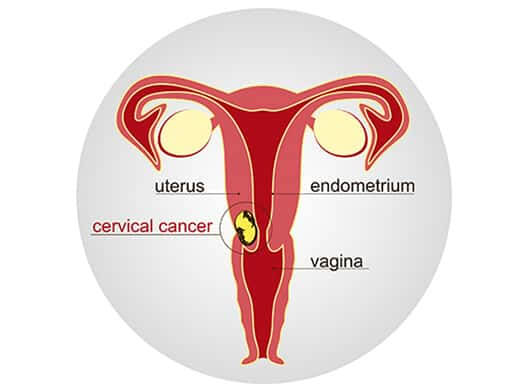- Procedures
- Imaging
- Laboratory
- PAP test - Cervical cancer can be detected through various screening tests. The most common screening test to detect cervical cancer or precancerous cells (dysplasia) is the Pap test. When precancerous or cancerous cells are found through a Pap test or pelvic examination, additional tests will be recommended to determine the presence of cervical cancer.
- Biopsy - During a biopsy a small sample of cervical cells or tissue is collected and sent for pathology evaluation.
- Colposcopy - It is a procedure that uses an instrument with a magnifying lens, called a Colposcope to examine the cervix for abnormalities. If abnormal tissue is found, a biopsy is usually performed (colposcopic biopsy) and small tissue samples will be removed for further examination.
- Endocervical curettage (ECC) or biopsy - It is a procedure to gently scrape the lining of the Endocervical canal (the area running the length of the cervix). This procedure may be done along with the colposcopy
- Loop electrosurgical excision procedure (LEEP)- A procedure that uses a thin electric wire loop to obtain a slightly larger sample of cervical tissue to be further evaluated. This procedure is usually done in the procedure room under local anesthesia
- Cone biopsy (conization)- a procedure in which a LEEP or cold-knife cone is used to remove a cone-shaped piece of cervical tissue for further examination. This procedure may require the use of general anesthesia. The cone biopsy procedure may be used to diagnose cervical cancer, as well as to treat or remove precancerous or early cancerous areas. This is usually performed if a diagnosis cannot be found after a colposcopy.
- CT scan is a diagnostic imaging procedure that uses x-rays to build cross-sectional images of the body. It also helps to identify the spread of cancer.
- Magnetic Resonance imaging (MRI) uses the interaction of radio waves and magnetic field which is processed in a high speed computer system to produce detailed scan pictures of the tissue, organs, bones, ligament and cartilage. It may be useful in detecting tumors and their metastases. This diagnostic technique offers greater soft tissue contrast than a CT scan.
- PET CT is considered to assess spread to regional nodes or distant metastases to other parts of the body. It provides functional and morphological details by utilizing radiation derived from Isotope labeled Glucose molecules to detect cellular glucose uptake, in cancer.
- Blood test - Tumor markers – Elevated levels of CEA and CA-19-9 are noted in patients with cervical cancer.



.png)
